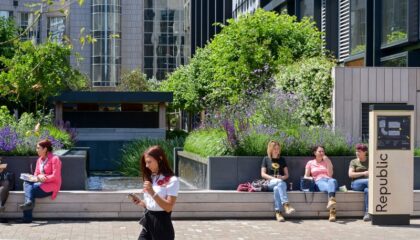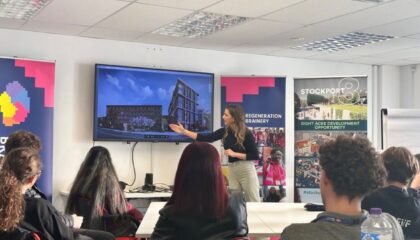Intelligent buildings could achieve up to 50% energy savings, writes James Hallworth, Senior Associate, Building Technology, in PlaceTech. But what practical steps should landlords and tenants take to meet sustainability targets – and why?
By 2050 every building will need to hit the Net Zero energy-use reduction goal to avoid the worst impacts of global warming in line with the Paris Agreement and UK government legislation. Targets have also been set for all new buildings to reach Net Zero by 2030.
One of the more measurable interventions to meet the challenge is the deployment of cloud-based, IoT-linked intelligent building technologies. A vital tool that puts owners and fund managers in the driving seat, building technology gives landlords oversight of key data for individual assets, so that they can track, and plan for, progress to net zero.
Here are five practical ways that building technology can make a measurable impact on sustainability targets:
1. Deliver energy efficiency
Up to 25% of energy in the commercial real estate sector is wasted, says the International Energy Agency (IEA). It has identified reductions in energy waste as the primary focus of any Net Zero Asset Plan.
Building technology can analyse live data to determine when and why existing plant and equipment are not working as they should be, and making the necessary adjustments, meaning systems can be optimised and energy wastage eliminated.
For instance, at one recently refurbished 30,000 sq. ft office building in the South East, intelligent building tech enabled a 60% energy reduction. By installing a building operating system which overlaid the buildings’ air handling unit, VRF and underfloor heating systems, we were able to optimise energy consumption by establishing automated rules for those systems based on occupancy and air quality levels.
2. Engage occupiers in sustainability
As occupiers increasingly look to landlords to provide the means for pursuing their own sustainability agenda, intelligent building technology allows occupiers to streamline their own energy use by linking their IoT sensor devices and smart meters to a central operating system.
Intelligent building solutions enable a whole-building approach, and so engagement with the people occupying the building is fundamental and comes with the quid pro quo of cost efficiencies for occupiers. Real time analysis of grid power carbon intensity can empower occupiers into making informed choices on energy use based on current carbon intensity levels.
Following a monitoring and targeting strategy using real-time granular data across a mixed office portfolio of nine properties spread nationwide, which accounted for 80% of the building owner’s total energy consumption (a £2.3 million spend), we introduced smart metering. The roll-out delivered 20% savings in the first year, equating to almost £500,000 of annual savings.
3. Maximise maintenance opportunities
While legacy building management systems are limited to acting as a warning light, state-of-the-art intelligent building systems precision-identify, diagnose, and adjust to automatically solve problems before they cost money or waste energy. Intelligent building control systems mean focused, automated and targeted maintenance, facilitating a two-way conversation between engineers and the building itself.
Through automated testing, engineers can identify, in a controlled environment, exactly which units require work, enabling targeted maintenance rather than blanket – often unnecessary – replacements. Digital twin simulations can recreate various breakdown or emergency scenarios and test the resilience of the building’s performance, with smaller bite-sized twin technology is more attainable across portfolios.
4. Maximise renewable energy
Ticking the on-site renewable energy box, for example with on-site power generation solutions such as solar PV arrays, is not enough without continuous performance monitoring to ensure equipment is running efficiently.
By linking operational data, and building a clear picture of how energy is being used in a specific asset, it’s possible to gain visibility and control over these facilities. Intelligent building operating systems can automatically improve efficiency, while flagging any operational faults that need attention.
The refurbishment of 10Brindley Place, a 212,000 sq. ft office space, provided the opportunity to integrate 840 sq. ft of on-site solar PV, contributing to 65% annual energy savings compared to a typical office of equal size. Intelligent building technology then provides live tracking data to ensure performance matches theoretical outputs.
5. Deliver an environment for health and wellbeing
Indoor air quality (IAQ) sensor advances mean that sensors are increasingly desirable in the battle against Covid-19. When harnessed in conjunction with intelligent building technology, indoor air quality sensors can measure carbon dioxide, relative humidity and temperature – and chemical pollutant levels – and make automated adjustments. The data gives landlords better insight into how they can improve the environment for the wellbeing of occupiers.
There are significant bottom-line gains to be made. In the wake of the pandemic, the premium for healthy spaces is likely to increase. By deploying technological solutions, building owners can keep occupiers safer by providing healthier workplaces.
James Hallworth is Senior Associate, Building Technology at Workman.
This article first appeared in PlaceTech.
Want to know more?
To find out how to make your buildings intelligent, read more about our IBOS platform.
Read more about Workman’s IBOS, the key to delivering smart buildings.
Read more about Workman’s IBOS, as reported by EG.
Read more about our ESG services.



